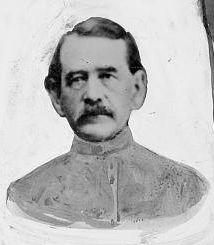William T. Martin
William Thompson Martin | |
|---|---|
 | |
| Born | March 25, 1823 Glasgow, Kentucky |
| Died | March 16, 1910 (aged 86) Natchez, Mississippi |
| Allegiance | Confederate States of America |
| Service/ | Confederate States Army |
| Rank | File:CSAGeneral.png Major General |
| Commands held | Jeff Davis Legion Martin's Cavalry Division Cavalry Corps, Longstreet's Command |
| Battles/wars | American Civil War |
| Other work | lawyer, politician, railroad president |
William Thompson Martin (March 25, 1823 — March 16, 1910) was an American lawyer and politician who became a Confederate States Army major general during the American Civil War. He later served in the Mississippi state senate, and was a delegate to four Democratic National Conventions. Martin was the president of the Natchez, Jackson, and Columbus Railroad, of which he oversaw the construction in 1884.
Biography
Early life
William T. Martin was born on March 25, 1823 in Glasgow, Kentucky. He graduated from Centre College in 1844 and was admitted to the bar in Mississippi.
Career
He served multiple terms as district attorney before the war. While himself opposing secession, he raised the Adams County cavalry troops, when war broke out, riding with them to Richmond, Virginia, the new Confederate States of America capitol. He quickly rose to colonel of the Jeff Davis Legion, and served with J.E.B. Stuart's command through Autumn 1862. Promoted to brigadier general, he was ordered to the Western Theater, where he commanded divisions at the Tullahoma Campaign and the Battle of Chickamauga and served as cavalry commander under James Longstreet at Knoxville. After Longstreet's return to the east, he was promoted to major general, led a division under Major General Joseph Wheeler at Atlanta and rose to command of the military district of Northwest Mississippi by war's end.
After the war, he returned to his law practice in Mississippi, becoming a trustee of both University of Mississippi and Jefferson College in Washington, Mississippi. He served in the state senate, and was a delegate to Democratic National Conventions in 1868, 1872, 1876, and 1880. He was the president of the Natchez, Jackson, and Columbus railroad, of which he oversaw the construction in 1884.
Personal life
He married Margaret (Dunlop Conner) Martin. They resided at Montaigne, a mansion in Natchez, Mississippi, now listed on the National Register of Historic Places.[1] They had eleven children.
Death
He died on March 16, 1910 in Natchez, Mississippi.
See also
Notes
- ^ Caroline Seebohm, Enshrining the Old South, The New York Times, February 10, 1991
References
- Boatner, Mark Mayo, III. The Civil War Dictionary. New York: McKay, 1988. ISBN 978-0-8129-1726-0. First published 1959 by McKay.
- Eicher, John H., and David J. Eicher, Civil War High Commands. Stanford: Stanford University Press, 2001. ISBN 978-0-8047-3641-1.
- Sifakis, Stewart. Who Was Who in the Civil War. New York: Facts On File, 1988. ISBN 978-0-8160-1055-4.
- Warner, Ezra J. Generals in Gray: Lives of the Confederate Commanders. Baton Rouge: Louisiana State University Press, 1959. ISBN 978-0-8071-0823-9.
